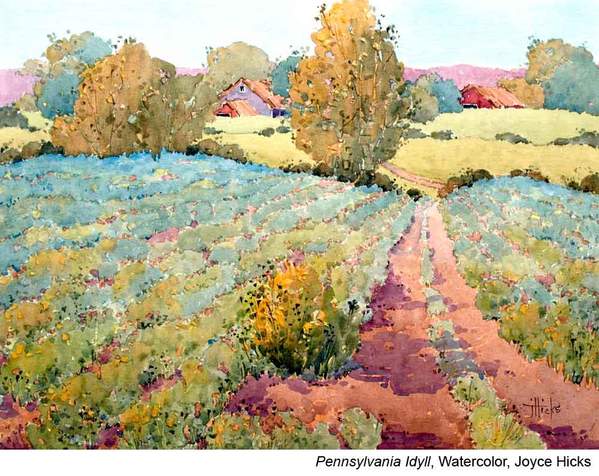
“The old adage of ‘less is more’ could not be more applicable than it is when creating a work of art,” says Joyce Hicks. “It is important to remember that your subject’s power and importance is diluted when competing with too many irrelevant parts and pieces.

“One of the most important skills an artist can develop is the ability to see and simplify subject matter. Sometimes in our excitement for a beautiful scene, we want to paint immediately and begin mindlessly covering the paper with too much unnecessary clutter and detail. The purpose of our painting should not be to act as a human camera recording everything in a photographic way but to translate the character and essence of the place in simple terms. I have always remembered these words I read long ago, ‘a painting isn’t good because it looks like something, it’s good because it feels like something.’

“Don’t paint things. Paint shapes and relationships instead! Think of a brick wall and your brain will see all the bricks. Think of a tree and your brain will imagine a million leaves. If you imagine the tree’s trunk your brain will see its bark. Thinking of ‘things’ is what leads to information overload in our paintings. Some artists overcome distracting detail by squinting their eyes.

“When you are trying to decide whether an object, element or shape should stay in your final composition ask yourself this question: Does it contribute to the message or theme of your painting? If your answer is no then leave it out.”

Learn more about Joyce Hicks’ process in these video workshops.
“I’ve always been able to visualize places and things in a very idealistic way, but it wasn’t until I discovered painting that I was able to express and interpret my own personal view of the world. My art is not always a true rendition of what is actually there but how I wish it could be. If the old white homestead is a bit neglected, then I will just capture it in sunlight to discover its real beauty. If there is only one withered rose on the old trellis then why not one hundred in full bloom? Frequent travel allows me to see and define what my heart is drawn to; not in the grand or extraordinary but in simple unassuming beauty. Painting gives me the opportunity to unite visual images with a montage of personal memories stored over my life time. In an attempt to translate my feelings for a subject I use interesting brush strokes, strong contrasts, sunlight and shadow in colors both soft and bold. These elements combine in a very personal and unique way providing a visual welcome mat, of sorts, tempting others into my world. My hope is to uplift the human spirit and inspire others to join me as I continue my artistic journey…..Joyce Hicks, AWS”








Beautiful!!! 🎨🖌️🎨
Well said Kelly. I’m new to watercolor – it’s an experience. I’ve recently remembered ‘less is more’ and am feeling better about my works.
Wow, what sweet looking colors she uses!
Joyce, Every painting you produce is such a testimony to your wonderful style and unique coloristic ability. They are just such a monumental example of the best of watercolor expressions.
Congratulations, Betsy Dillard Stroud
Thanks for the encouraging article! Your examples are fresh and beautiful. I struggle with boring washes when I try to just focus on painting shapes, instead of “things”. Then, to break the boredom, I start adding details that lead to an overworked piece. You seem to be good at knowing when to stop. I’m going to begin thinking about and considering every brush stroke.
I really appreciate the examples of how to change things to your personal vision. Your words “tell us”, your paintings “show us”. Very effective message! Thank you!